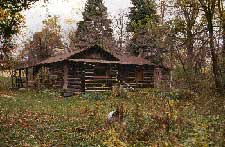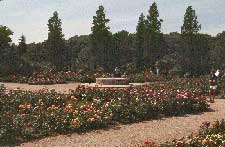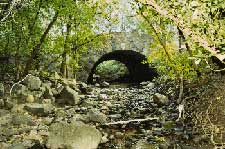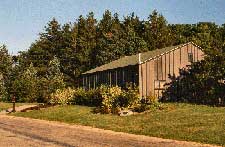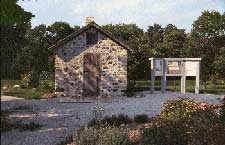MILWAUKEE COUNTY LANDMARKS
Hales Corners
Boerner Botanical Gardens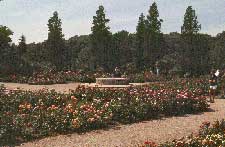
Whitnall Park
Hales Corners
Landmark Designation: 1977
Boerner Botanical Gardens and Whitnall Park are named for two men who made major contributions to the Milwaukee county park system. Charles B. Whitnall was responsible for the acquisition of much park land including the 630 acres that make up Whitnall Park. As a longtime member of the County Park Commission, Whitnall was particularly interested in the preservation of natural landscapes and urged the Commission to purchase undeveloped land for future parks at a time when prices were still relatively low. It was not long before the growth of the county’s population would have made this impossible.
As county landscape architect, Alfred A. Boerner planned the design of Whitnall Park, its botanical gardens, and arboretum. His intention was to make a visit to the gardens both inspiring and educational. Paths are laid out which lead visitors from one garden area to another. Labels tell gardeners which plant varieties may be grown successfully in Wisconsin’s climate. A plaque recognizing Boerner’s contributions to the parks was placed at the entrance to the gardens in 1957.
St. Mary’s Church Cemetery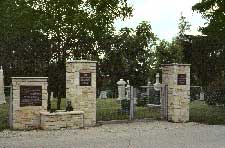
South 95th Street and West Edgerton Avenue
Hales Corners
Landmark Designation: 1981
When it was organized in 1842, St. Mary’s Catholic Church was one of the earliest parishes in rural Milwaukee County. Most of its original 140 families were Irish immigrants, and the parish had strong ties to Greenfield ’s Irish farming community, remnants of which still exist today in the Jeremiah Curtin House and Trimborn Farm sites. The oldest tombstone in St. Mary’s Cemetery is dated 1842 although the cemetery was not officially established until 1846 when William Furlong donated the land to the Diocese of Milwaukee. A lannon stone wall, built around the cemetery in 1967 as part of the parish’s 125th anniversary, holds three plaques which describe the parish’s history.
The present church, the fifth building to serve the parish, was completed in the late 1990s. The school, staffed by the School Sisters of St. Francis, was built in 1953 with an addition in 1960.
Ben Hunt’s Cabin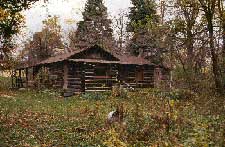
5885 South 116th Street
(formerly located at 11221 West Janesville Road )
Hales Corners
Landmark Designation: 1984
W. Ben Hunt, a writer and illustrator of Indian crafts and lore, built the cabin behind his Hales Corners house in 1924 to use as a workshop for handicrafts. Originally the cabin consisted of only one large room with a fireplace at one end and a homemade stove at the other. Later a kitchen and combination workshop, library and office were added. Hunt belatedly discovered he had built the cabin incorrectly. As an example, he put in the chimney first instead of last. However, the erroneous method was the one used in his book on building a log cabin.
A well-known resident of Hales Corners, Hunt wrote and illustrated articles on Indian craft and lore under the name of “Lone Eagle” and also a carving column under the pen name of “Whittling Jim” for Boys’ Life, the official magazine of the Boy Scouts of America. He taught handicrafts for the Hales Corners Boy Scout troop and later acted as handicraft commissioner for the Milwaukee Area Boy Scout Council. Hunt also served on the staff of Boys’ Life magazine. He reached a large audience through eighteen books on various handicrafts, including his most famous How to Build a Log Cabin, first published in 1939 as Building a Log Cabin. Other books included Indian and Camp Handicraft, Ben Hunt’s Big Book of Whittling, Indian Silversmithing, and The Flat Bow.
The Hales Corners Historical Society restored the cabin and turned it into a museum of handicraft history.
Civilian Conservation Corps (CCC) Building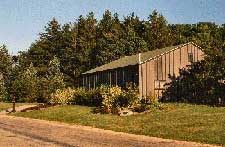
5879 South 92nd Street
Hales Corners
Landmark Designation: 1996
This structure is located in Whitnall Park and is the only remaining CCC building in Milwaukee County . It was used as a repair shop in the 1930s while the park was being built. In the mid-1980s, the structure was restored by the Friends of Boerner Botanical Gardens.
Milwaukee County Parks Statuary
Milwaukee, Cudahy and Hales Corners
Landmark Designation: 1997
Fifteen outdoor sculptures honoring notable personages related to the heritage of Milwaukee citizens or identifying historical themes significant to the development of the area were dedicated at sites within the Milwaukee County Park System between 1881 and 1996. The sculptures designated for their historic significance include the following:
- Robert Burns (1909) – Franklin Place Triangle
- Leif, the Discoverer (1887) – Juneau Park
- Pledge Allegiance (1991) – O’Donnell Park
- Immigrant Mother (1960) – Cathedral Park
- Pere Jacques Marquette (1987) – Pere Marquette Park
- Solomon Juneau (1887) – Juneau Park
- General Thaddeus Kosciuszko (1905) – Kosciuszko Park
- Commerce (1881) – Jackson Park
- Casimer Pulaski (1932) – Pulaski Park, Cudahy
- Goethe – Schiller (1908) – Washington Park
- Patrick Cudahy (1965) – Sheridan Park
- Reflecting Pool Statuary (1936) – Boerner Botanical Gardens
Whitnall Park - Garden Statuary (1936) – Boerner Botanical Gardens
Whitnall Park - Christian Wahl (1903) – Wahl Park
- Erastus B. Wolcott (1920) – Lake Park
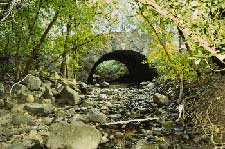 Civilian Conservation Corps (CCC) Bridges, Whitnall Park
Civilian Conservation Corps (CCC) Bridges, Whitnall Park
Hales Corners
Landmark Designation: 2001
Spanning Whitnall Park Creek just east of Highway 100 in Hales Corners, these two concrete deck arches with fieldstone veneers were built by the Civilian Conservation Corps (CCC) during 1933-34. The CCC also built the Garden House at the Boerner Botanical Gardens, another Milwaukee County Landmark. These bridges’ stone parapet walls rise at the center of the arch and extend as curved wing walls. Each is 28 feet long and exhibits excellent design integrity.
The land was originally purchased by Charles B. Whitnall in the late 1920s for a park where Milwaukee citizens could have intimate contact with nature. Whitnall, Secretary of the Milwaukee County Park Commission, and Alfred L. Boerner, Milwaukee County landscape architect, together created their vision of a natural environment. The CCC had camps in Whitnall Park from the spring of 1933 until 1938. Federal work relief programs played a critical role in the development of Milwaukee County parks and parkway system throughout the 1930s. These bridges exhibit the construction techniques and craftsmanship of typical CCC projects and were designed to blend into the surrounding naturescape.
Seneca Hale Summer Kitchen / Spring House, Cobb Park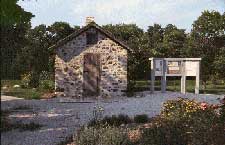
East of S. 116th and W. Janesville Rd.
Hales Corners
Landmark Designation: 1998
The Hale summer kitchen was built by Seneca Hale in the 1850s. It was located behind his house, which was on the west side of Forest Home Avenue (Hwy. 00). During 1995-1997, the summer kitchen was reconstructed and relocated to Cobb Park (just east of the intersection of S. 116th Street and W. Janesville Road). This was accomplished through the collaboration of the Hales Corners Historical Society, the Village of Hales Corners, and numerous volunteers.
The relocation to Cobb Park kept the summer kitchen within the quarter-section purchased by Seneca Hale in 1840, and on land donated to the village and dedicated to the memory of Seneca Hale and his grandson, Irwin Cobb.
A summer kitchen was common in the 1850s. It provided a place to prepare meals, bake, and heat water for bathing and laundry. More important, it kept the heat of a wood-burning stove out of the house during summer months and reduced the possibility of a farmhouse fire.
The Hale summer kitchen has exterior dimensions of approximately 12′ x 16′. The corners consist of large pieces of cut limestone. The body of the two-foot-thick walls are filled with ordinary uncut fieldstones of various types and sizes. The stovepipe is not vented horizontally through the wall, as was usually done. Instead, there is a hollow cavity running vertically through the middle of the wall up to the peak and into the brick chimney.

